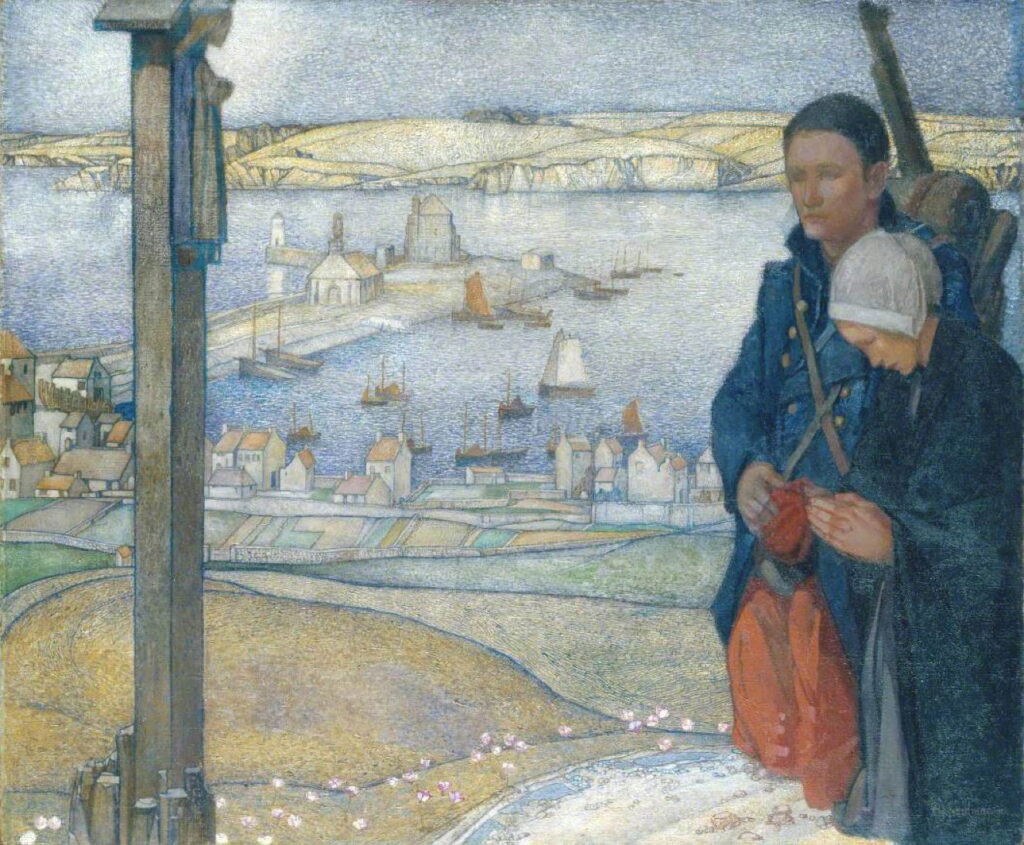The 100th anniversary of Reginald Frampton’s death: A late Pre-Raphaelite

The Pre-Raphaelite Movement continued to attract new artists until the end of the nineteenth century. Among them was Edward Reginald Frampton (1872-1923), who died a century ago today (or possibly, according to some, tomorrow, 5 November). Although largely forgotten today, his murals live on in churches around England, and his style has an unusual fusion of influence from the French Symbolist Pierre Puvis de Chavannes and the Pre-Raphaelite Edward Burne-Jones.
Frampton was the son of a successful artist in stained glass, and went to school and trained in art alongside Aubrey Beardsley. He followed those studies up by working with his father for seven years, and in long periods spent in Italy and France. He first became a member of the Royal Society of British Artists in 1894, and the following year started to exhibit annually at the Royal Academy. Late in his career he turned more to landscapes.
Edward Reginald Frampton (1872-1923), Saint Cecilia (1898), further details not known. Wikimedia Commons.
Frampton’s Saint Cecilia from 1898 shows the saint sat playing a pipe organ and singing, as another figure (Valerian perhaps) levitates behind her back. This may refer to Cecilia’s wedding night and the angel she invoked to preserve her virginity despite her marriage.
Edward Reginald Frampton (1872-1923), Isabella, or the Pot of Basil (date not known), further details not known. Wikimedia Commons.
He probably painted Isabella, or the Pot of Basil towards the end of the nineteenth century, or possibly in the early twentieth. This tells the tragic story of Lisabetta from the fourth day of Boccaccio’s Decameron. She is kneeling at an altar, before her pot of basil containing the head of her lover Lorenzo.
Edward Reginald Frampton (1872-1923), A scene from The Tempest (date not known), further details not known. Wikimedia Commons.
Frampton’s undated Scene from The Tempest shows Prospero and Miranda playing chess, from William Shakespeare’s play The Tempest.
Edward Reginald Frampton (1872-1923), The Voyage of Saint Brendan (1908), media and dimensions not known, Chazen Museum of Art, University of Wisconsin-Madison, Madison, WI. Image by Daderot, via Wikimedia Commons.
The Voyage of Saint Brendan from 1908 shows the legendary voyage of Brendan the Navigator (c 484-577), one of the twelve Apostles of Ireland, in search of the Promised Land. That is supposed to have lasted seven years, before he returned to Ireland.
Edward Reginald Frampton (1872-1923), A Madonna of Brittany (c 1913), oil on canvas, 51.5 x 47 cm, The Cartwright Memorial Hall (Art Gallery And Museum), Bradford, England. Wikimedia Commons.
Like many painters of the time, Frampton was moved by the piety of the women of north-west France, as expressed in A Madonna of Brittany from about 1913. He shows a contemporary young woman with a traditional halo superimposed on a section of the region’s rugged coastline, with local fishing boats.
Edward Reginald Frampton (1872-1923), Brittany: 1914 (1920), oil on canvas, 92.6 x 76.8 cm, The Tate Gallery, London. Wikimedia Commons.
In 1920, he revisited north-west France in Brittany: 1914. A young soldier is kneeling with his wife at a crucifix above a small fishing port, as he is about to go off to fight in the Great War.
Edward Reginald Frampton (1872-1923), Elaine, the Lady of Shallott (1920), oil on canvas, 63.5 × 38 cm, location not known. Wikimedia Commons.
His Elaine, the Lady of Shallott of 1920 is a scene from Tennyson’s poem Lancelot and Elaine from his Arthurian cycle Idylls of the King. This shows Elaine, daughter of Bernard of Astolat, guarding the knight’s shield while he is away at a tournament, after she had fallen in love with him.
Edward Reginald Frampton (1872-1923), Cumberland Idyll (1920-22), further details not known. Wikimedia Commons.
Frampton’s Cumberland Idyll from 1920-22 is a symbolist landscape in the style of Puvis de Chavannes set in the rocky hills of the English Lake District, in the north west, at Springtime. A young woman stands naked, washing her clothes on a rock by a stream.
Edward Reginald Frampton (1872-1923), The South Downs near Eastbourne, East Sussex (date not known), tempera on card, 33 x 41.6 cm, Russell-Cotes Art Gallery & Museum, Bournemouth, England. Wikimedia Commons.
Finally, his undated view of The South Downs near Eastbourne, East Sussex shows the south-east coast of England during haymaking, with sporadic red poppies in the foreground. The land is otherwise peaceful and deserted, and its sky rises to eternity.
On 4 November 1923, when he was on his way to Austria, Reginald Frampton died suddenly in Paris; he was only fifty-one.




